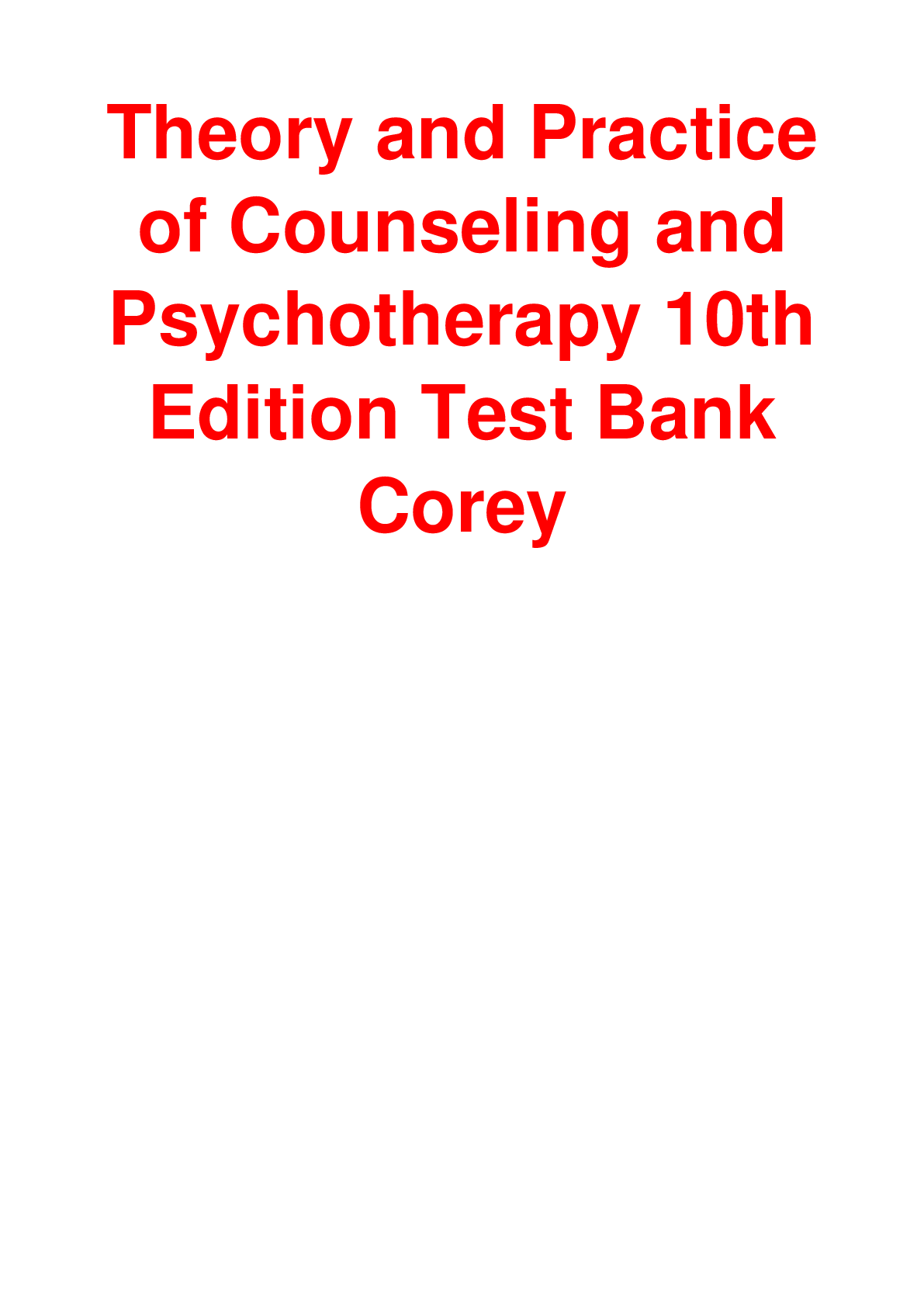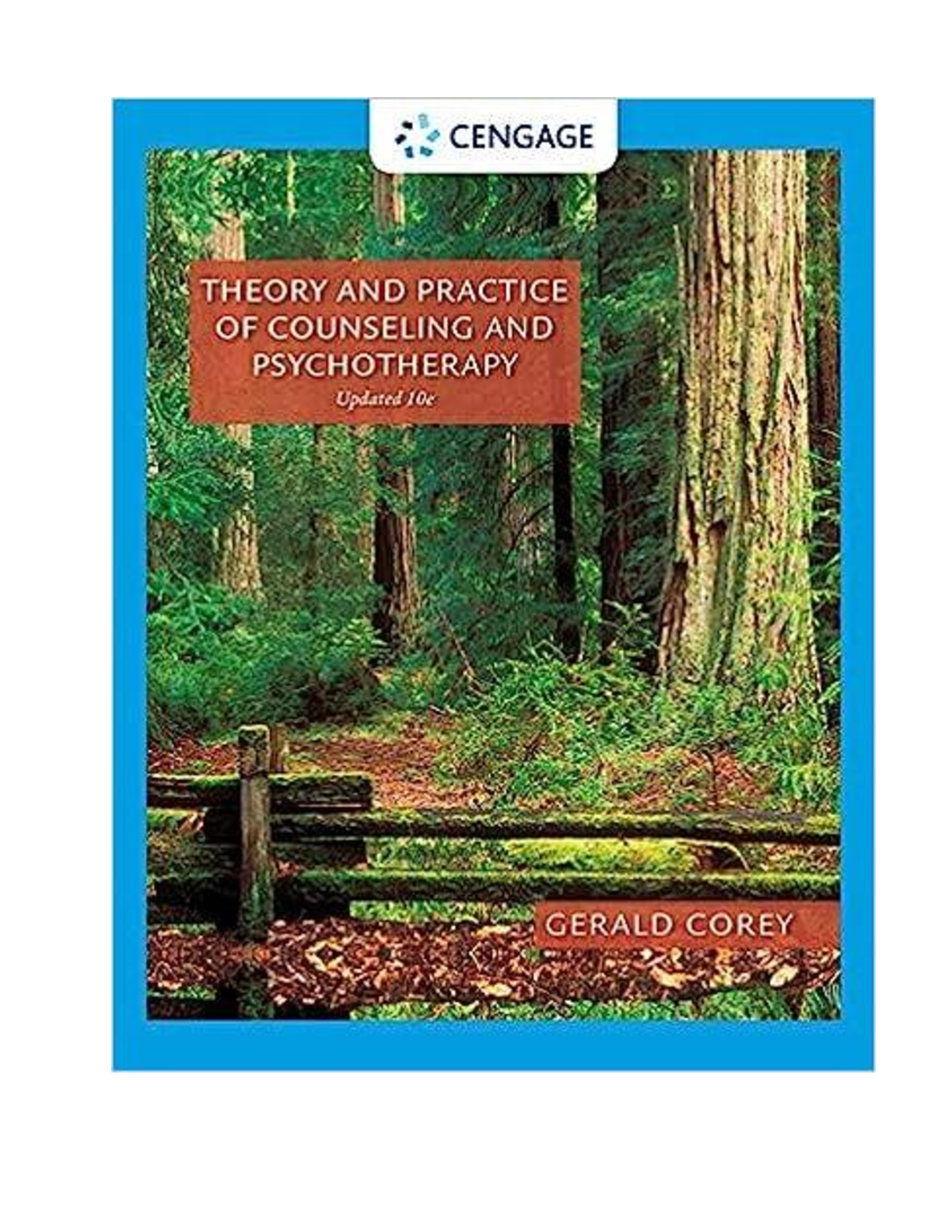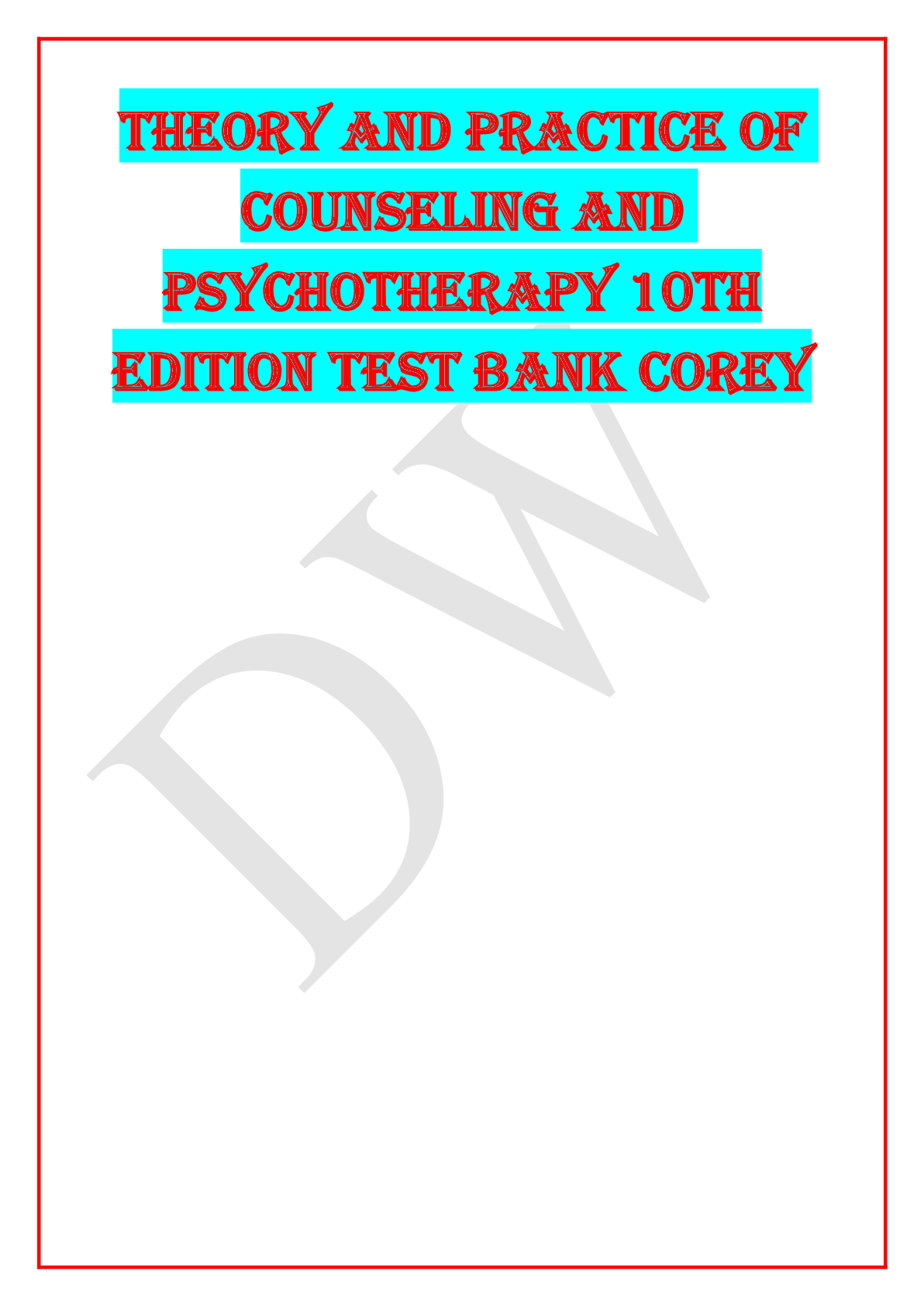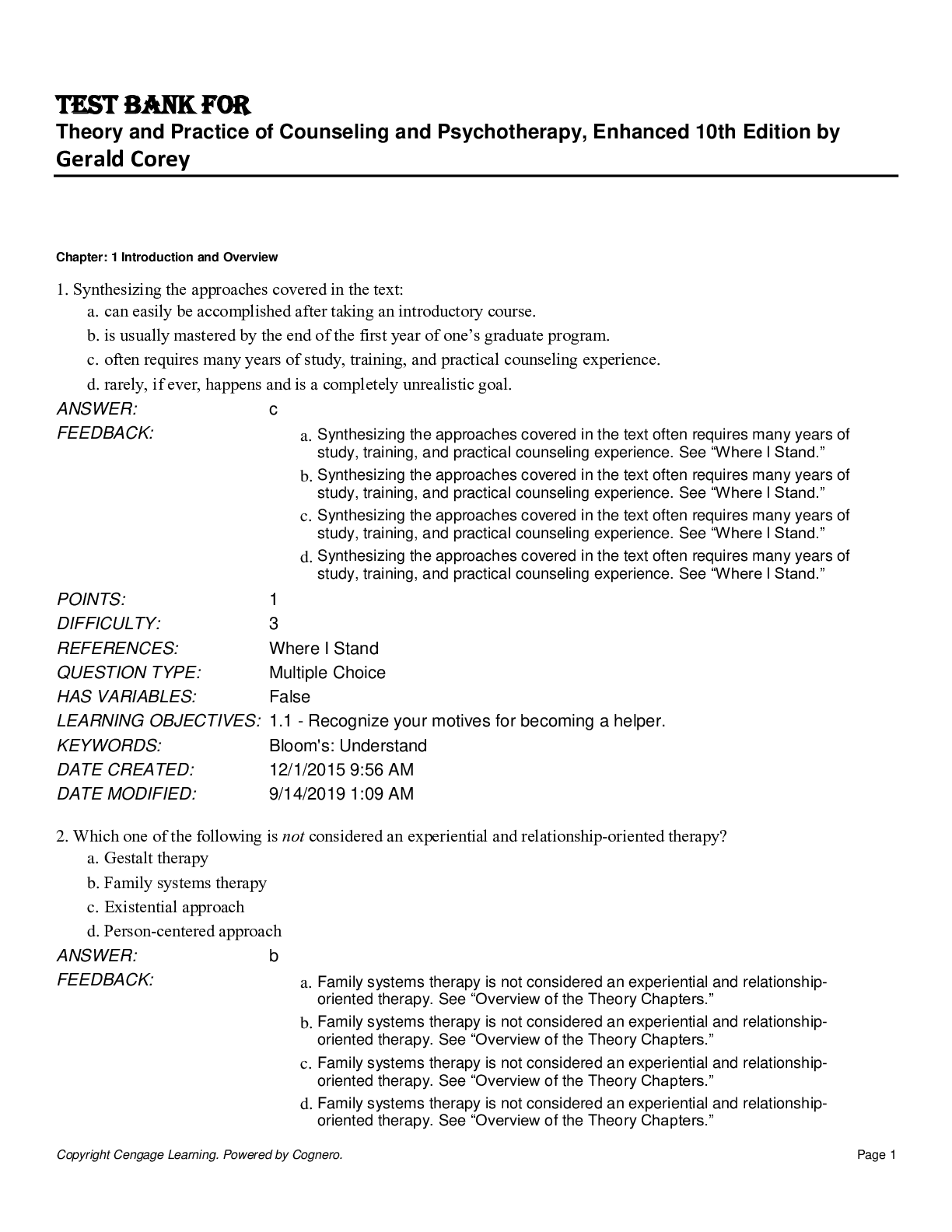Health Care > TEST BANKS > Test Bank for Theory and Practice of Counseling and Psychotherapy, International Edition 11th Editio (All)
Test Bank for Theory and Practice of Counseling and Psychotherapy, International Edition 11th Edition By Dr. Gerald Corey
Document Content and Description Below
Test Bank for Theory and Practice of Counseling and Psychotherapy, International Edition 11th Edition By Dr. Gerald Corey-1. Synthesizing the approaches covered in the text: a. can easily be accompli... shed after taking an introductory course. b. is usually mastered by the end of the first year of one’s graduate program. c. often requires many years of study, training, and practical counseling experience. d. rarely, if ever, happens and is a completely unrealistic goal. ANSWER: c POINTS: 1 DIFFICULTY: 3 REFERENCES: From My Point of View QUESTION TYPE: Multiple Choice HAS VARIABLES: False LEARNING OBJECTIVES: 1.1 - Explain the author’s philosophical stance. KEYWORDS: Bloom’s: Understand 2. Which one of the following is considered an experiential and relationship-oriented therapy model? a. Feminist therapy b. Cognitive behavior therapy c. Behavior therapy d. Person-centered approach ANSWER: d POINTS: 1 DIFFICULTY: 1 REFERENCES: Theory Chapters – An Overview QUESTION TYPE: Multiple Choice HAS VARIABLES: False LEARNING OBJECTIVES: 1.3 - Differentiate between each contemporary counseling model discussed in this book. KEYWORDS: Bloom’s: Remember 3. Which of the following is associated with the cognitive-behavioral action-oriented therapy model? a. Existential therapy b. Psychoanalytic therapy c. Choice theory/Reality therapy d. Family systems therapy ANSWER: c POINTS: 1 DIFFICULTY: 1 Page 2 REFERENCES: Theory Chapters – An Overview QUESTION TYPE: Multiple Choice HAS VARIABLES: False LEARNING OBJECTIVES: 1.3 - Differentiate between each contemporary counseling model discussed in this book. KEYWORDS: Bloom’s: Remember 4. Which of the counseling therapies has the primary role of thinking, as it relates to influencing behavior? a. Psychoanalytic b. Adlerian c. Person-centered d. Cognitive-behavioral ANSWER: d POINTS: 1 DIFFICULTY: 1 REFERENCES: Theory Chapters – An Overview QUESTION TYPE: Multiple Choice HAS VARIABLES: False LEARNING OBJECTIVES: 1.3 - Differentiate between each contemporary counseling model discussed in this book. KEYWORDS: Bloom’s: Remember 5. Which of the following is not a concept covered in the book? a. A brief historical sketch of how and why theories were developed b. Application of the theory to the cases of Stan and Gwen c. A discussion of strategies to improve mental health through a medical model d. Application of the theory from a multicultural perspective ANSWER: c POINTS: 1 DIFFICULTY: 3 REFERENCES: How to Use this Book QUESTION TYPE: Multiple Choice HAS VARIABLES: False LEARNING OBJECTIVES: 1.2 - Identify suggested ways to use this book. KEYWORDS: Bloom’s: Remember 6. The author makes a case for a. initially getting an overview of the major theoretical orientations and then learning a particular approach by becoming steeped in that approach for some time. b. delving deeply into one approach initially and then taking a superficial look at other theoretical models. c. learning the theories of counseling only after starting to work with clients in order to make the theories more relevant. d. the reader to choose the approach to which he or she subscribes. ANSWER: a POINTS: 1 DIFFICULTY: 5 REFERENCES: From My Point of View QUESTION TYPE: Multiple Choice Page 3 HAS VARIABLES: False LEARNING OBJECTIVES: 1.1 - Explain the author’s philosophical stance. KEYWORDS: Bloom’s: Understand 7. Which of the following statements about administrative techniques is true according to the author? a. Techniques are substitutes for hard work when developing constructive client-therapist relationships. b. Administrating techniques to clients without regard for the relationship variables is ineffective. c. Knowledge about personality dynamics is not a requirement for affective client-therapist relationships. d. To be a successful counselor one should not use personal experiences and reactions to serve your clients. ANSWER: b POINTS: 1 DIFFICULTY: 5 REFERENCES: From My Point of View QUESTION TYPE: Multiple Choice HAS VARIABLES: False LEARNING OBJECTIVES: 1.1 - Explain the author’s philosophical stance. KEYWORDS: Bloom’s: Understand 8. Which of the following is the main focus of the book? a. Addressing ethical issues by balancing personal and professional values b. Establishing a good therapist–client relationship through collaborative efforts c. Improving the mental health of clients d. Developing an integrative approach to various theories ANSWER: d POINTS: 1 DIFFICULTY: 3 REFERENCES: How to Use this Book QUESTION TYPE: Multiple Choice HAS VARIABLES: False LEARNING OBJECTIVES: 1.2 - Identify suggested ways to use this book. KEYWORDS: Bloom’s: Understand 9. Which of these statements about interventions is true? a. It is helpful to use one type of intervention with most clients. b. During the course of an individual’s therapy, different interventions may be needed at different times. c. It is best to require clients to adapt to your approach to counseling and the interventions that you are skilled at using. d. You should only use counseling interventions when you are certified or licensed. ANSWER: b POINTS: 1 DIFFICULTY: 3 REFERENCES: From My Point of View QUESTION TYPE: Multiple Choice HAS VARIABLES: False LEARNING OBJECTIVES: 1.1 - Explain the author’s philosophical stance. KEYWORDS: Bloom’s: Understand Page 4 10. Which of the following assumes there is no single truth; rather, it is a belief that reality is social constructed through human interaction? a. Postmodern approach b. Family systems therapy c. Adlerian approach d. Reality therapy ANSWER: a POINTS: 1 DIFFICULTY: 1 REFERENCES: Theory Chapters – An Overview QUESTION TYPE: Multiple Choice HAS VARIABLES: False LEARNING OBJECTIVES: 1.3 - Differentiate between each contemporary counseling model discussed in this book. KEYWORDS: Bloom’s: Remember 11. In the case of Stan, what are some of the key themes of his life from his intake interview? a. He puts himself down a lot but wants to feel better about himself. b. He has many concerns related to work. c. He is emotional an angry d. He prefers to spend time with himself over family and friends ANSWER: a POINTS: 1 DIFFICULTY: 5 REFERENCES: The Case of Stan: An Introduction QUESTION TYPE: Multiple Choice HAS VARIABLES: False LEARNING OBJECTIVES: 1.4 - Identify key issues presented in the case of Stan. KEYWORDS: Bloom’s: Understand 12. Which of the following statements best describes the author’s view of the medical model? a. Corey appreciates the focus on psychopathology and believes it gives clinicians the tools to assess what’s wrong with clients. b. A focus on the medical model restricts therapeutic practice because it stresses deficits rather than strengths. c. The medical model emphasizes strengths and competencies rather than psychopathology. d. The medical model is especially relevant for culturally diverse client populations. ANSWER: b POINTS: 1 DIFFICULTY: 5 REFERENCES: From My Point of View QUESTION TYPE: Multiple Choice HAS VARIABLES: False LEARNING OBJECTIVES: 1.1 - Explain the author’s philosophical stance. KEYWORDS: Bloom’s: Understand Page 5 13. Which of the following was the main significance of conducting video sessions for Gwen? a. Different therapists worked on their own approaches. b. Techniques and programs were conducted based on the preferences of Gwen. c. Gwen was able to present her problems within a limited time period. d. Gwen was able to relate her past experiences to the present experiences. ANSWER: a POINTS: 1 DIFFICULTY: 3 REFERENCES: Experience Counseling Sessions with Gwen QUESTION TYPE: Multiple Choice HAS VARIABLES: False LEARNING OBJECTIVES: 1.6 - Describe the key themes of the video counseling sessions with Gwen. KEYWORDS: Bloom’s: Understand 14. Gwen was requested to which of the following in the informed consent session? a. To know about the use of techniques b. To know about the number of sessions and the time duration c. To discuss the differences in race and culture d. To understand the conditions under which consulting with a supervisor would be preferred ANSWER: c POINTS: 1 DIFFICULTY: 3 REFERENCES: The Case of Gwen: An Introduction QUESTION TYPE: Multiple Choice HAS VARIABLES: False LEARNING OBJECTIVES: 1.5 - Identify key issues presented in the case of Gwen. KEYWORDS: Bloom’s: Remember 15. Which of the following is not an issue that Stan struggles with? a. Fear of being alone b. Fear of intimate relationships with women c. Substance use d. Aggressive outbursts ANSWER: d POINTS: 1 DIFFICULTY: 1 REFERENCES: The Case of Stan: An Introduction QUESTION TYPE: Multiple Choice HAS VARIABLES: False LEARNING OBJECTIVES: 1.4 - Identify key issues presented in the case of Stan. KEYWORDS: Bloom’s: Understand 16. The counselor of Stan provided Stan counseling by analyzing from theoretical details from cognitive behavioral therapy alone. a. True Page 6 b. False ANSWER: False POINTS: 1 DIFFICULTY: 1 REFERENCES: The Case of Stan: An Introduction QUESTION TYPE: True / False HAS VARIABLES: False LEARNING OBJECTIVES: 1.4 - Identify key issues presented in the case of Stan. KEYWORDS: Bloom’s: Understand 17. In the case of Stan, the counselor could find attributes of different models to incorporate into a personal style of counseling. a. True b. False ANSWER: True POINTS: 1 DIFFICULTY: 3 REFERENCES: The Case of Stan: An Introduction QUESTION TYPE: True / False HAS VARIABLES: False LEARNING OBJECTIVES: 1.4 - Identify key issues presented in the case of Stan. KEYWORDS: Bloom’s: Understand 18. Stan came to counseling because his personal problems made his friends stay away from him. a. True b. False ANSWER: False POINTS: 1 DIFFICULTY: 1 REFERENCES: The Case of Stan: An Introduction QUESTION TYPE: True / False HAS VARIABLES: False LEARNING OBJECTIVES: 1.4 - Identify key issues presented in the case of Stan. KEYWORDS: Bloom’s: Remember 19. Gwen sought counseling because she had difficulty staying focused at work and generally felt sad and overwhelmed. a. True b. False ANSWER: True POINTS: 1 DIFFICULTY: 3 REFERENCES: The Case of Gwen: An Introduction QUESTION TYPE: True / False HAS VARIABLES: False LEARNING OBJECTIVES: 1.5 - Identify key issues presented in the case of Gwen. KEYWORDS: Bloom’s: Remember [Show More]
Last updated: 5 months ago
Preview 5 out of 275 pages

Loading document previews ...
Buy this document to get the full access instantly
Instant Download Access after purchase
Buy NowInstant download
We Accept:

Reviews( 0 )
$14.50
Can't find what you want? Try our AI powered Search
Document information
Connected school, study & course
About the document
Uploaded On
Jan 06, 2025
Number of pages
275
Written in
Additional information
This document has been written for:
Uploaded
Jan 06, 2025
Downloads
0
Views
13

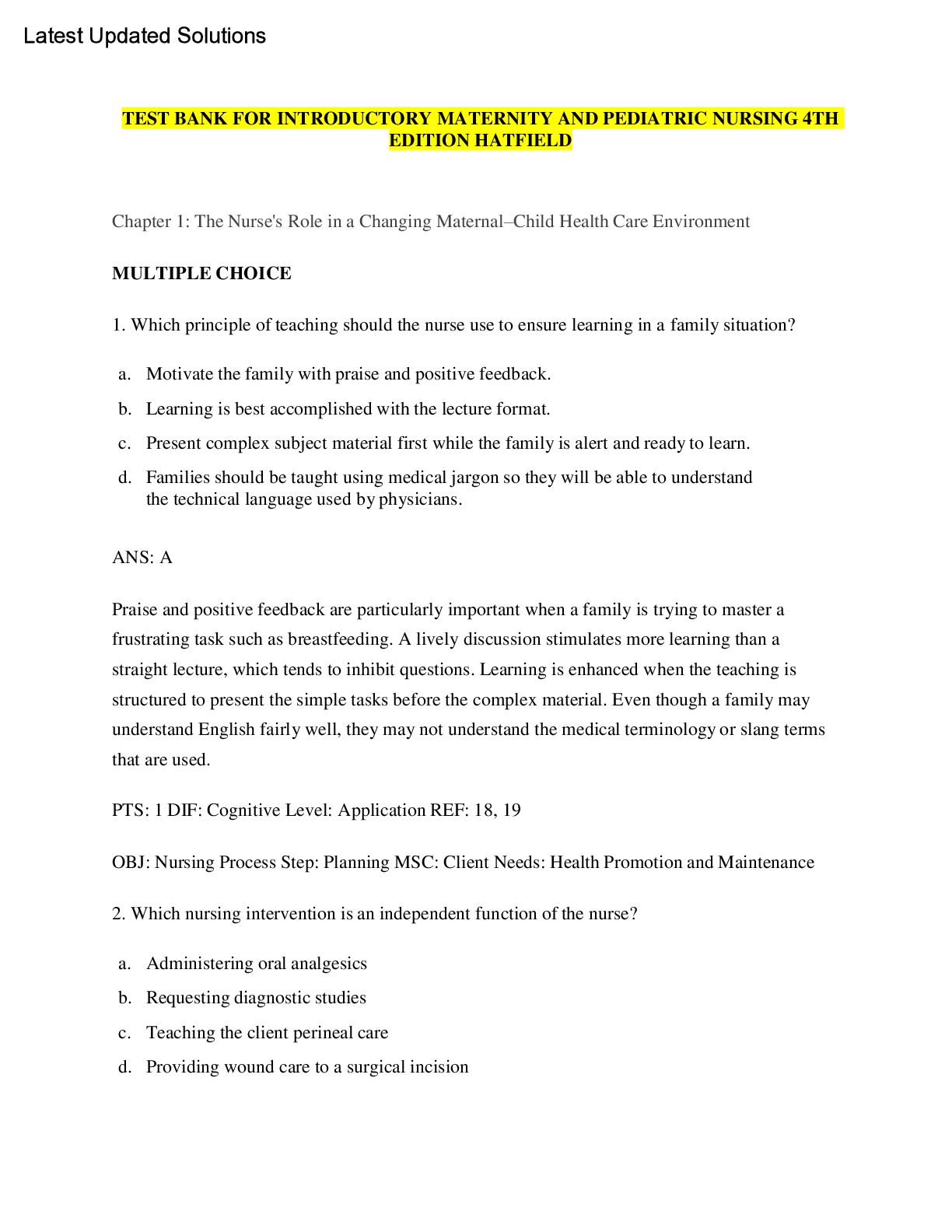
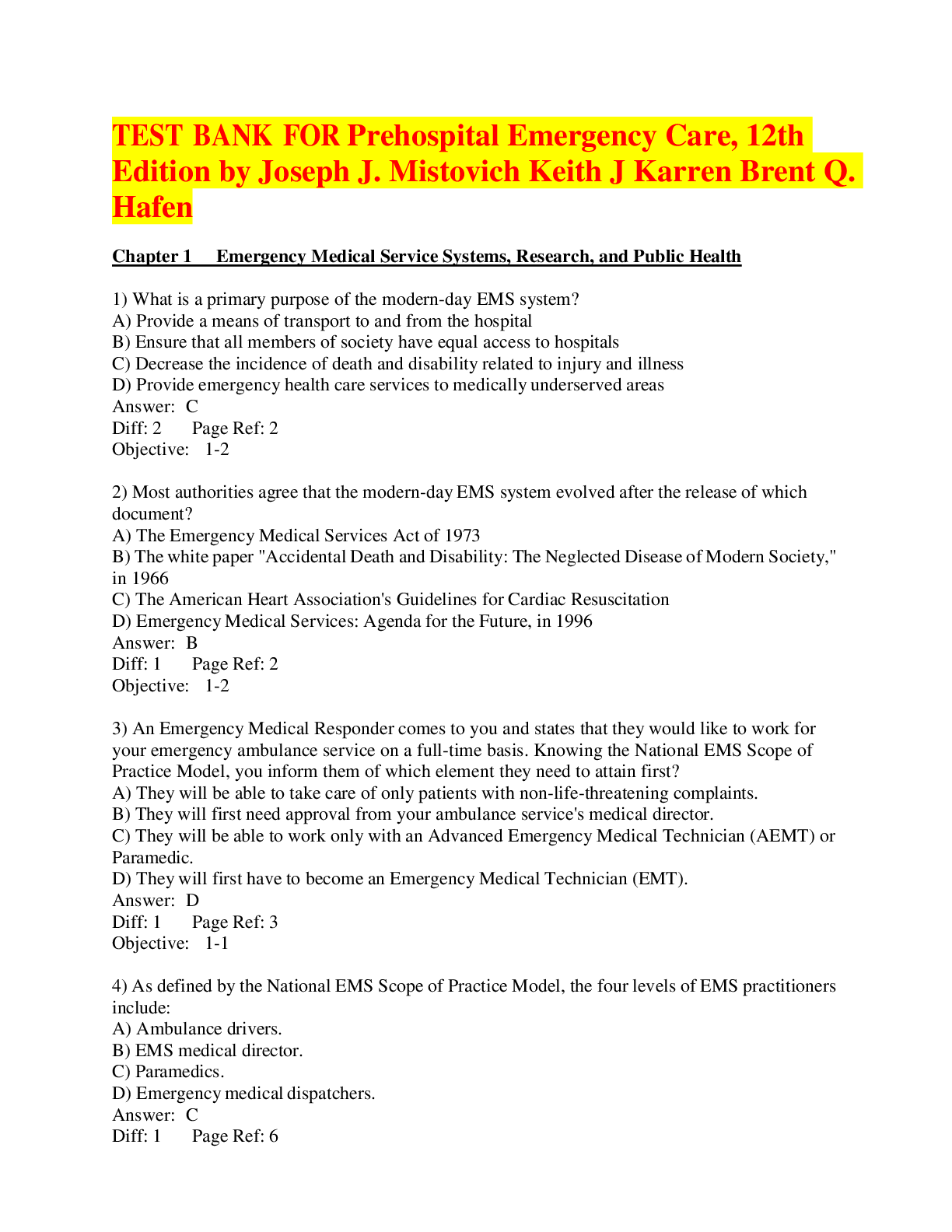


_compressed.png)
.png)
.png)


.png)




